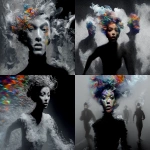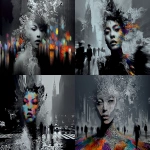Explore the Best AI Image Gallery
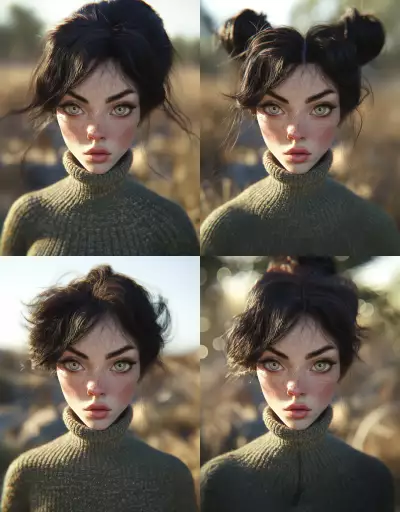
The AI Artist: Reimagining Graphic Design with Intelligent Tools
The graphic design landscape is undergoing a profound transformation, driven by the emergence of powerful artificial intelligence (AI) tools. These intelligent systems are not merely automating tasks; they are redefining the creative process itself, empowering designers to achieve new levels of efficiency, innovation, and artistic expression.
AI in graphic design encompasses a wide range of applications, from generating stunning visuals to streamlining workflows and personalizing designs. Lets delve into the exciting possibilities and challenges this paradigm shift presents.
Potential Uses of AI in Graphic Design
- Logo and Brand Identity Creation: AI algorithms can analyze industry trends, target audiences, and brand values to generate unique logo concepts.
- Image Generation and Editing: Tools like DALL-E 2 and Midjourney enable designers to create original images from text descriptions, while AI-powered editing software can enhance existing visuals with remarkable precision.
- Content Creation and Layout Design: AI can assist in generating marketing materials, social media posts, and website layouts, freeing up designers to focus on strategic concepts and brand storytelling.
- Personalized Design Experiences: AI can analyze user preferences and data to create customized designs for products, websites, and marketing campaigns, delivering a more engaging and personalized experience.
The Ethical Considerations
While AI offers immense potential, its integration into graphic design raises important ethical considerations:
- Copyright and Ownership: Questions arise regarding the ownership of AI-generated content. Who holds the copyright—the user who provides the input, the developer of the AI tool, or the AI itself?
- Bias and Representation: AI algorithms are trained on vast datasets, which can reflect existing societal biases. Its crucial to ensure that AI-generated designs do not perpetuate harmful stereotypes or discrimination.
- Transparency and Accountability: The decision-making processes of complex AI models can be opaque. Designers should strive for transparency in how AI is used and be accountable for the outputs it generates.
Future Trends in AI-Powered Graphic Design
The future of graphic design is undoubtedly intertwined with AI. Here are some emerging trends to watch:
- More Intuitive and User-Friendly Tools: AI platforms will become increasingly accessible to designers of all skill levels, empowering them to leverage AIs capabilities without needing extensive technical expertise.
- Real-Time Collaboration and Feedback: AI can facilitate collaborative design processes by providing real-time feedback, suggesting improvements, and automating repetitive tasks.
- Hyper-Personalized Design Experiences: AI will enable the creation of truly personalized designs that adapt to individual preferences, behaviors, and contexts.
- The Rise of AI-Generated Art as a New Medium: As AIs creative capabilities evolve, we can expect to see a surge in AI-generated art, blurring the lines between human and machine creativity.
Conclusion
AI is revolutionizing graphic design, offering powerful tools that enhance creativity, efficiency, and personalization. By embracing these advancements responsibly and addressing ethical considerations, designers can harness the transformative power of AI to shape the future of visual communication.
The journey into the world of AI-powered graphic design is just beginning. As technology continues to evolve, we can anticipate even more groundbreaking innovations that will redefine the creative landscape.




](https://images.ai-img.art/thumbnails/150/bd056a4718c27444e064198762f8dc8ffa1f74f1afd7dcda8d5cb8b142797d6e.webp)








](https://images.ai-img.art/thumbnails/150/0ba0be922ab76af53f75ab90126ae2b18a600ee3b96941e8ab897a9f10594e5a.webp)


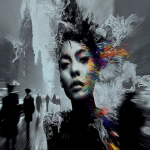
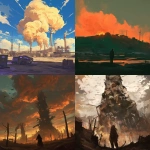



](https://images.ai-img.art/thumbnails/150/a3ed6513a6661aa3ee46e0c2924d1e8888854e91d8908de39db5590dc41f8d8f.webp)


](https://images.ai-img.art/thumbnails/150/2ebdeb4f7db35100e5be5de9bc3e533a40d14e5feedefd7ffc586524a0f3ba8c.webp)

](https://images.ai-img.art/thumbnails/150/7cf5a08238f29c821f52bb4f63db48af0b7f633ff3b9f7253074d78ced9ff6f6.webp)



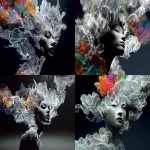
](https://images.ai-img.art/thumbnails/150/685ae68cfab93a7e59a71206867b060c45bd6fd3cd561c4fe60fca514b09c5f8.webp)

](https://images.ai-img.art/thumbnails/150/ff09e32d2be011c0dd785984c5c1e47839ce551a31da1bde242860b30df2aa30.webp)



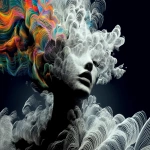


](https://images.ai-img.art/thumbnails/150/847809c77ca9a73b68bc190e6efb06fec87157685a243730d5a66a403b0e6e10.webp)
